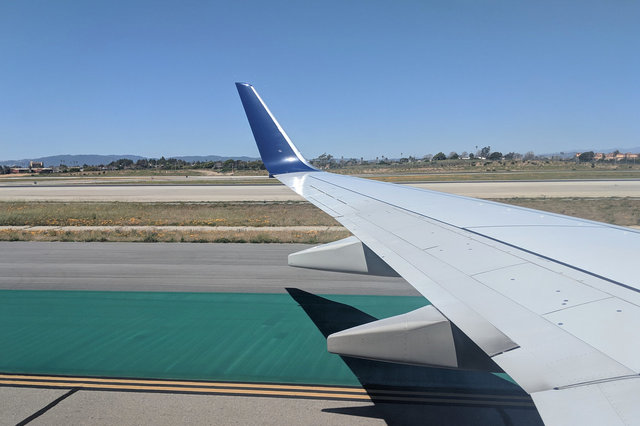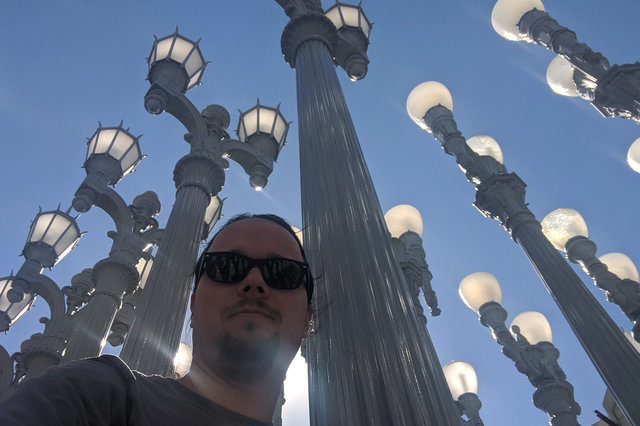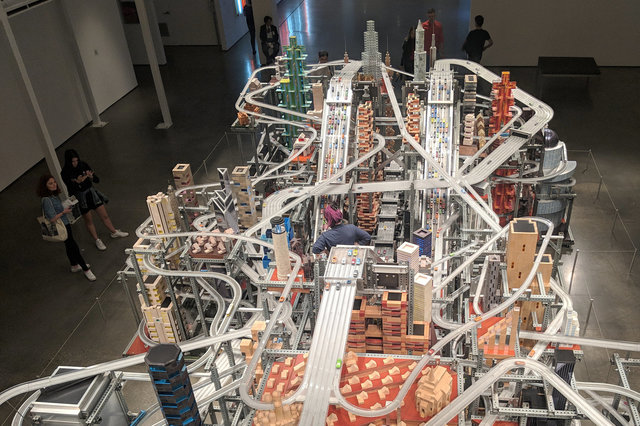LAX
Started: 2019-04-26 16:13:13
Submitted: 2019-04-28 13:51:19
Visibility: World-readable
17 March 2019: In which the intrepid narrator heads to Los Angeles to visit his favorite public radio business show
The first time I remember listening to the public radio business show Marketplace was in the summer of 2003, when I turned on the radio to one of the local public radio stations in Boulder while cleaning up my parents' basement after moving out on my own. By 2005, I'd moved to Longmont, and I learned that if I tuned to KUNC, the public radio station from Greeley, I could hear Marketplace at 17:30 while I was driving home. (The other station I could easily listen to, Colorado Public Radio's KCFR, kept playing All Things Considered.) Within a couple of years I grew tired of KUNC's habit of preempting or talking over Marketplace, and as podcasts began to grow in their popularity and reach, Marketplace became available on a podcast. By 2008 I was listening to Marketplace every day via podcast, getting my public radio straight from the source at a time when NPR was still trying to figure out what a podcast was and was afraid of putting too much of its content in podcast form. I never looked back.
At some point in the aughts, Kiesa and I formalized our charitable giving arrangement: we would set aside 10% of our take-home income as a tithe, but instead of explicitly giving it to the church (as we had done growing up) we would select tax-exempt charitable organizations and give that money to them. (It helped that, as soon as we bought a house at the end of 2004 and began making mortgage interest payments, we started itemizing deductions on our Federal taxes.) My strategy for dividing my contributions was to select an assortment of direct international aid, public radio, and local organizations, with public radio near the top of my list (because I benefited directly from it). (I last blogged about my selection of charities in 2010.)
As my income increased, my charitable contribution budget increased with it. I tended to save up my charity until the end of the calendar year, when I'd come up with my overall plan for the year and give it away all at once. (I know charities prefer regular monthly giving, but I find that harder to manage, especially when collating all of my contributions for my tax return. Some of my charities have figured this out; EFF, in particular, has a check-box for annual recurring contributions.)
So it turned out that, when perusing my charities last December, I noticed that Marketplace had a reward tier for a visit to their headquarters and studio in downtown Los Angeles. I thought about it for a minute then signed up.
Then the rest of the winter happened, and I spent most of my discretionary time escaping the Seattle winter for the desert east of San Diego (in two separate trips, in January and February). By the time I found a good spot on my calendar to visit Los Angeles it was March; I figured it was a good opportunity to visit the sun.
Sunday, 17 March
My morning flight from Seattle to Los Angeles took me past the crest of the Sierra-Nevada Mountains; at one point I looked out my window and saw Yosemite Valley spread out before me, from El Capitan to Half Dome, with the higher elevations around the valley still covered in snow.
Further on the route took me across the Central Valley, where square fields in different shades of green and brown grew much of the nation's food.
I watched Los Angeles out my window as we approached LAX, descending through the smog past the suburban sprawl filled with bungalows and small apartment builds and strip malls, all laid out on a regular grid and painted in various shades of southwest pastel stucco topped with red roofs. As we landed at LAX I could see that the superbloom had spread to the runway median: tiny orange California poppies, growing wild, had sprouted among the grass beneath the wing of my plane.
I rented a car in the warm spring sun and drove across western Los Angeles, out of the light industrial developments supporting the airport, past the Inglewood Oil Field (Los Angeles' original oil wells, still producing oil, the grasshopper heads of the oil wells gently rocking up and down after a century of extraction) to the Los Angeles County Museum of Art.
My first stop at the museum was the art installation Urban Light, where recovered lamp posts from around Los Angeles had come to live out their retirement.
My next stop was the food trucks across the street. I considered my options (including a very-tempting taco truck; I had, after all, come to Southern California mostly to eat tacos (and, to be fair, visit Marketplace)) and ended up eating pupusas at a veg-friendly truck serving food from El Salvador. The bean-and-cheese stuffed into the pouch of dough and fried was delicious, as was the fried plantain thing for dessert.
I returned back across Willshire Boulevard to LACMA and entered the museum. Much of the collection in the main building (a mid-century modern building that might have been Brutalist if it hadn't been faced with elegant travertine) were packed up and closed because the building was slated for demolition and replacement in the next few years. (They didn't say why, though it wouldn't surprise me if it were in need of a seismic retrofit and it turned out to be more economical to rebuild from scratch.) I focused on the modern art; the museum's collection had a random assortment of artists I did and didn't recognize, including a small room showing artists from the Bay Area. There was an interesting exhibit on 3D, showing a bunch of stereoscopic images in various formats (complete with icons to indicate which viewing apparatus we should use, all of which were provided: colored glasses, polarized glasses, or optical spreaders (if the stereoscopic images were presented side-by-side)).
Then I saw my favorite art installation in the whole museum: Metropolis II.
This was a huge racetrack for matchbox-sized cars, running around in packs on a network of tracks, winding from the top of a conveyer belt back to the bottom of the conveyer belt. The cars sped past buildings made out of various materials, including large Erector Set towers. Together the cars put off a shrill buzzing noise not unlike a swarm of bees.
There was a human attendant inside the installation, supplied with earplugs, who attended to the physical needs of the machine: turning it on and off during its operating hours, and rescuing cars that got stuck on the tracks. I walked around the installation several times, and studied it from the upper viewing platforms, before its scheduled running hours expired, and the attendant turned it off, and I watched the cars come to a stop and the noise subside.
I left the museum to wander around the grounds of the adjacent La Brea Tar Pits, where tar still bubbles to the surface, laying traps for any Ice Age animals still wandering about, and a lake now sits where preserved skeletons were excavated and displayed in the adjacent museum. This is one of the few places in Los Angeles I remember visiting as a child, on a visit to Los Angeles that I remember little else about.
I headed to my hotel, in the Los Angeles neighborhood of Marina Del Mar, next to the neighborhood of Venice Beach, next to the city of Santa Monica. I ate supper in Santa Monica (and remembered it was St. Patrick's Day from the drunken crowds in the Irish pubs I passed), then went to walk along the beach. It was dark, and I was the only person on the beach, though the beach was clearly designed for crowds of people in the sun. I walked along the sand to the water's edge, watching the waves break in front of me. To my right, a mile away along the beach, I could see the lights of the Santa Monica boardwalk. I missed the beach, missed feeling the soft sand under my feet and the gentle persistent roar of the waves breaking and the salt spray on my face. I gazed out into the darkness across the Pacific Ocean to the horizon.
I left the beach and headed back to my hotel, ready to see Marketplace the next day.








